Autonomous self-driving technologies may be grabbing headlines for vehicle manufacturers but it’s hardly the only direction in which carmakers are innovating. Infotainment systems bring a smartphone-like platform for software applications straight to the dashboard, providing everything from navigation assistance to streaming music services and even phone call capabilities. Knob-based radio and air conditioning controls are being replaced by touch-sensitive displays and voice-controlled services connecting drivers and passengers to Internet-based services. According to market research reports, the market for in-car infotainment systems is expected to rise from $14.4 billion in 2016 up to $35.2 billion in 2020.
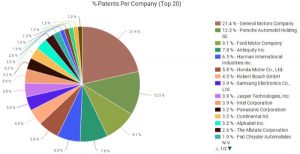 Taking a look at the U.S. patent landscape for vehicle infotainment shows automakers far ahead of consumer electronics companies in terms of portfolio, a pattern which also plays out for autonomous vehicle patents as well. According to Innography’s patent portfolio analysis tools, the three largest vehicle infotainment patent portfolios belong to General Motors (NYSE:GM), Porsche Automobil (ETR:PAH3) and Ford Motor Company (NYSE:F). One-fifth of the market belongs to GM and the top three companies combined account for more than 40 percent of the U.S. patent market for vehicle infotainment systems. By contrast, Samsung Electronics (KRX:005930) holds 3.9 percent of the market, tied with Intel Corporation (NASDAQ:INTC) and slightly ahead of Alphabet at 3.2 percent.
Taking a look at the U.S. patent landscape for vehicle infotainment shows automakers far ahead of consumer electronics companies in terms of portfolio, a pattern which also plays out for autonomous vehicle patents as well. According to Innography’s patent portfolio analysis tools, the three largest vehicle infotainment patent portfolios belong to General Motors (NYSE:GM), Porsche Automobil (ETR:PAH3) and Ford Motor Company (NYSE:F). One-fifth of the market belongs to GM and the top three companies combined account for more than 40 percent of the U.S. patent market for vehicle infotainment systems. By contrast, Samsung Electronics (KRX:005930) holds 3.9 percent of the market, tied with Intel Corporation (NASDAQ:INTC) and slightly ahead of Alphabet at 3.2 percent.
Ford, of Dearborn, MI, looks to take an early lead in this sector with the recent announcement that its entire lineup of 2017 vehicles will come with its Sync 3 infotainment technology. Sync 3 is the third generation of Ford’s infotainment technology. It can process voice commands, provides a touch-sensitive LCD screen and can pair with a smartphone to make additional apps available directly through the infotainment system.
 Infotainment technologies are at the center of a patent application recently filed by Ford, U.S. Patent Application No. 20160167516, titled Method and Apparatus for Infotainment System Control Through a Wireless Device Operating-System-Independent Protocol. This patent application discloses a system including a wireless device processor that communicates wirelessly with a remote vehicle infotainment system, receives web-based control display instructions, displays an infotainment control interface, receives input through that interface and submits requests to control the interface based upon the received instructions. This technology allows for greater control of in-vehicle infotainment systems through a paired device such as a smartphone.
Infotainment technologies are at the center of a patent application recently filed by Ford, U.S. Patent Application No. 20160167516, titled Method and Apparatus for Infotainment System Control Through a Wireless Device Operating-System-Independent Protocol. This patent application discloses a system including a wireless device processor that communicates wirelessly with a remote vehicle infotainment system, receives web-based control display instructions, displays an infotainment control interface, receives input through that interface and submits requests to control the interface based upon the received instructions. This technology allows for greater control of in-vehicle infotainment systems through a paired device such as a smartphone.
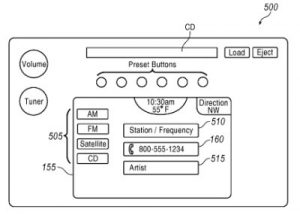 Last November, Ford added to its infotainment system patent portfolio with the issue of U.S. Patent No. 9191135, titled Contact Information Recognition System for External Textual Data Displayed by In-Vehicle Infotainment Systems. It protects a media content processor installed in a vehicle and having a control unit that locates contact information found in metadata fields descriptive of received media content and a display screen that displays the metadata fields. When contact information is displayed in a metadata field, the display also includes a user interface option associated with selecting the metadata field. This innovation makes greater use of metadata tagged to media content broadcast over the radio for display and use in an infotainment system. For example, this system would allow users to interact with phone number and social media metadata tagged to radio broadcasts for increased interaction with a radio station.
Last November, Ford added to its infotainment system patent portfolio with the issue of U.S. Patent No. 9191135, titled Contact Information Recognition System for External Textual Data Displayed by In-Vehicle Infotainment Systems. It protects a media content processor installed in a vehicle and having a control unit that locates contact information found in metadata fields descriptive of received media content and a display screen that displays the metadata fields. When contact information is displayed in a metadata field, the display also includes a user interface option associated with selecting the metadata field. This innovation makes greater use of metadata tagged to media content broadcast over the radio for display and use in an infotainment system. For example, this system would allow users to interact with phone number and social media metadata tagged to radio broadcasts for increased interaction with a radio station.
The recent announcement by Ford also underscores the continuing influence of major Silicon Valley companies in the auto manufacturing sector. The version of Sync 3 found in all 2017 Fords will also be compatible with both Apple CarPlay and Android Auto, operating systems for vehicle infotainment units which have been developed respectively by Apple Inc. (NASDAQ:AAPL) of Cupertino, CA, and Mountain View, CA-based Google, a subsidiary of Alphabet Inc. (NASDAQ:GOOGL) Both of these platforms sync compatible smartphones to infotainment display units to provide multimedia, navigation tools, phone calls and a variety of apps. The two systems also provide speech recognition for the use of voice commands.
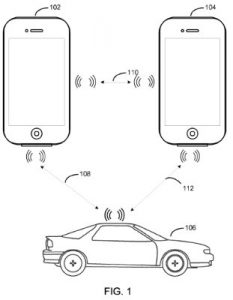 One Apple technology involving the use of a portable electronic device in communication with an automobile is discussed in U.S. Patent No. 9351102, entitled Accessing a Vehicle Using Portable Devices. It protects a method for accessing a secured object which includes receiving an access credential at a portable electronic device to access the secured object and transmitting an additional access credential to a second portable device which enables access to the secured object through a direct connection. This innovation provides a means by which a first device can configure additional devices to access a certain vehicle via a Bluetooth connection.
One Apple technology involving the use of a portable electronic device in communication with an automobile is discussed in U.S. Patent No. 9351102, entitled Accessing a Vehicle Using Portable Devices. It protects a method for accessing a secured object which includes receiving an access credential at a portable electronic device to access the secured object and transmitting an additional access credential to a second portable device which enables access to the secured object through a direct connection. This innovation provides a means by which a first device can configure additional devices to access a certain vehicle via a Bluetooth connection.
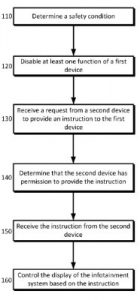 Google’s developments related to infotainment systems can be seen in U.S. Patent Application No. 20160207400, which is titled Passenger Casted Content to Infotainment System. It would protect a method of determining a safety condition by a first mobile device associated with a driver, disabling a function of the first mobile device in response to determining the safety condition, receiving an infotainment system instruction from a second device and controlling the infotainment system according to the instruction. This system is designed to reduce driver distraction when accessing navigation tools or other infotainment system functions while the car is in motion. Control of the infotainment system is locked to the driver and is instead pushed to a device carried by a passenger in the vehicle.
Google’s developments related to infotainment systems can be seen in U.S. Patent Application No. 20160207400, which is titled Passenger Casted Content to Infotainment System. It would protect a method of determining a safety condition by a first mobile device associated with a driver, disabling a function of the first mobile device in response to determining the safety condition, receiving an infotainment system instruction from a second device and controlling the infotainment system according to the instruction. This system is designed to reduce driver distraction when accessing navigation tools or other infotainment system functions while the car is in motion. Control of the infotainment system is locked to the driver and is instead pushed to a device carried by a passenger in the vehicle.
Interestingly, although Android and iOS split the market in the smartphone world, the same isn’t true in the growing in-vehicle infotainment system market. Whereas you would only find one system operating on any given smartphone, vehicle manufacturers haven’t been showing a preference and instead have been incorporating both at the same time. South Korean carmaker Hyundai Motor Co. (KRX:005830) recently announced that both systems will be available on upgraded versions of its 2017 Sonata and Tucson. Japan’s Nissan Motor Co. (TYO:7201) only offers Apple CarPlay in its Maxima but a video released by the company indicates that future models may be compatible with both systems. A software update available in late July to vehicles made by South Korea’s Kia Motors (KRX:000270) allows owners to integrate both Apple CarPlay and Android Auto into cars having Kia’s UVO infotainment systems. Making both systems available to consumers is likely more valuable to automakers who don’t want to lose out on sales simply because a potential customer doesn’t have a compatible smartphone.
Some companies are also developing aftermarket equipment options for car owners who want to retrofit their vehicles with infotainment systems. In late June, Japanese electronics developer JVC Kenwood (TYO:6632) began shipments of a 6.8-inch touchscreen receiver with RCA outputs, USB ports and Bluetooth connectivity. Compared to the dual system compatibility preferred by auto manufacturers, the JVC receiver currently only supports Apple CarPlay. An aftermarket receiver providing both systems has been developed by Japanese electronics company Pioneer Corporation (TYO:6773). That company has unveiled in-dash receivers offering both the Android and Apple systems at the most recent Consumer Electronics Show in Las Vegas.

![[IPWatchdog Logo]](https://ipwatchdog.com/wp-content/themes/IPWatchdog%20-%202023/assets/images/temp/logo-small@2x.png)

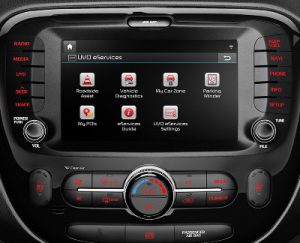
![[Advertisement]](https://ipwatchdog.com/wp-content/uploads/2024/04/Patent-Litigation-Masters-2024-sidebar-early-bird-ends-Apr-21-last-chance-700x500-1.jpg)

![[Advertisement]](https://ipwatchdog.com/wp-content/uploads/2021/12/WEBINAR-336-x-280-px.png)
![[Advertisement]](https://ipwatchdog.com/wp-content/uploads/2021/12/2021-Patent-Practice-on-Demand-recorded-Feb-2021-336-x-280.jpg)
![[Advertisement]](https://ipwatchdog.com/wp-content/uploads/2021/12/Ad-4-The-Invent-Patent-System™.png)







Join the Discussion
No comments yet.